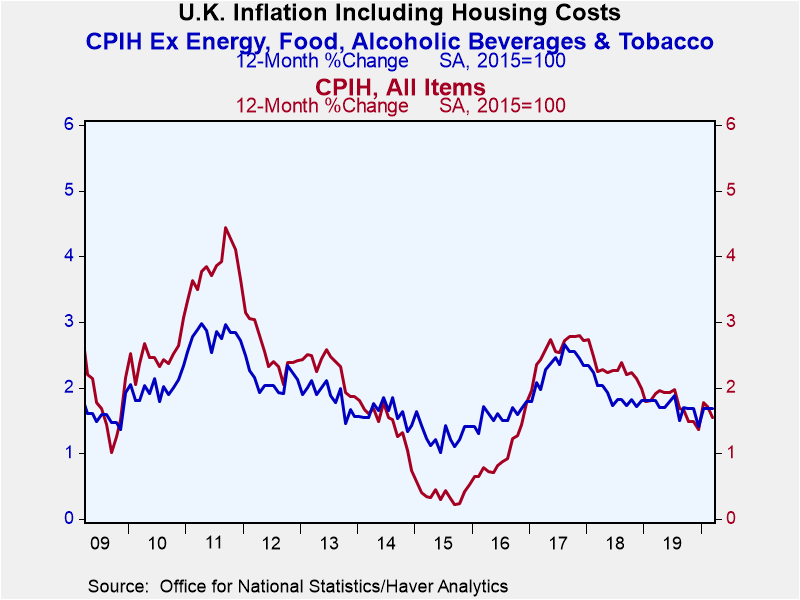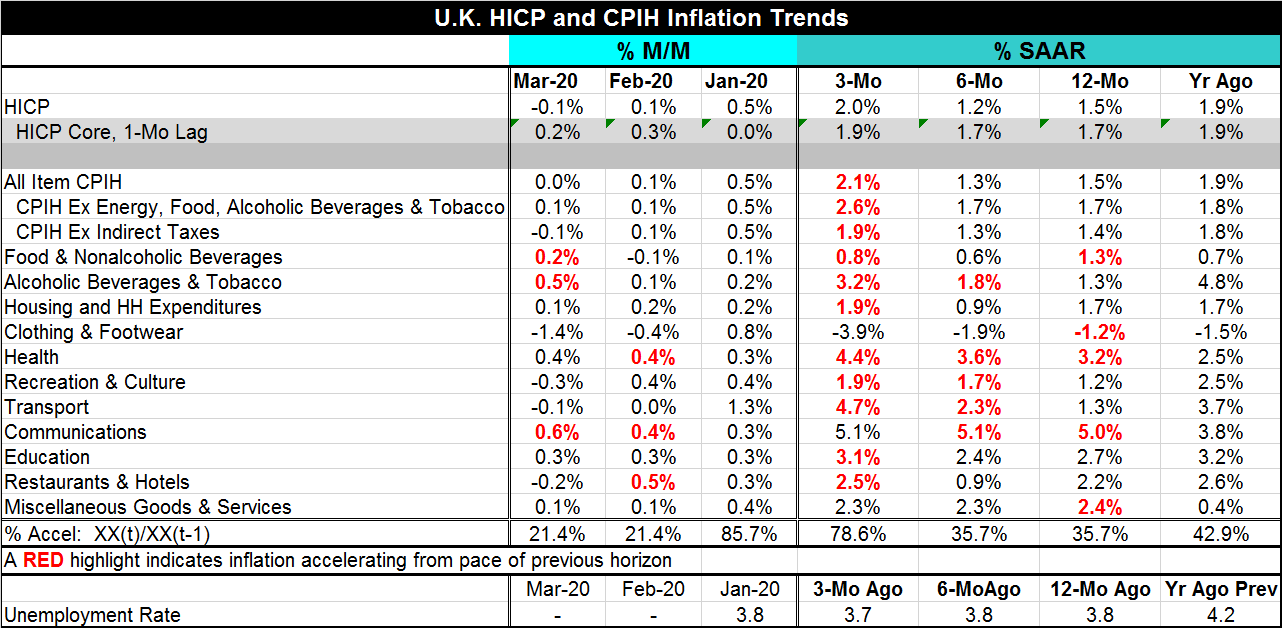 Global| Apr 22 2020
Global| Apr 22 2020U.K. Inflation Steps Back; COVID-19 Lurks Less Than People Think
Summary
U.K. inflation has remained tame. In December there was a broad-based acceleration, but that has dissipated in February and March. In March and February, only about 21% of the major categories and the headline accelerated month-to- [...]
 U.K. inflation has remained tame. In December there was a broad-based acceleration, but that has dissipated in February and March. In March and February, only about 21% of the major categories and the headline accelerated month-to-month. In March, the CPIH was flat, the core was up by 0.1%, and the HICP definition for the price index saw prices fall by 0.1%.
U.K. inflation has remained tame. In December there was a broad-based acceleration, but that has dissipated in February and March. In March and February, only about 21% of the major categories and the headline accelerated month-to-month. In March, the CPIH was flat, the core was up by 0.1%, and the HICP definition for the price index saw prices fall by 0.1%.
The year-on-year graphic for the U.K. shows inflation decelerating rather steadily after peaking in 2017. The diffusion data in the table confirm and underscore that the trends on several annual periods and sub-annual sequential periods as well as over the recent three months largely agree.
Inflation metrics of such different periodicities do not always reveal the same trends; in this case, they do substantially.
Of course, declining prices are now underpinned by dropping oil prices and those prices promise to remain on the weak side of history for some time. Brent crude prices have fallen for three months in a row. Year-on-year Brent prices have fallen for two months in a row as well as in 10 of the last 12 months, leaving a long trail of weak energy prices in the pipeline.
Nonetheless, the CPIH accelerates from three-months to six-months (2.1% vs. 1.3%). Over three months, CPIH categories show acceleration in nearly 79% of the major divisions. However, that was a break from the previous two years and the monthly data make it clear that the price pressures seen in January are now on the run.

With the coronavirus stalking growth and governments throwing up various patchwork arrangements to try to support the out of work who remain substantially unsupportable, there is a large segment of the population at economic risk. Government programs will help some and save some. But there is going to be a lot of pain over this virus given the way it has been handled.
In the U.S., the Federal Reserve has made it clear that it is talking to epidemiologists because economic forecasts cannot be made without their input. So rather than saying "We all Keynesians now," I will say 'we are all epidemiologists now.' And so what does that mean? I'm afraid it means that we are at the whim of what the pandemic specialists want to do and how they view this crisis. And I find this disturbing because they are locked in their own group-think with protocols for action that make NO SENSE TO ME. Maybe they are fans of David Byrne's?
I assume that COVID-19 is COVID-19 is COVID-19. In other words, I assume that the disease 'is the same everywhere' but depending on local demographics and even on how it is approached its impact could play out differently. The table below shows you why I am so upset with how global health authorities have dealt with the virus. Look at the panel under 'Shares.' Here we present the NYC data on COVID-19 deaths by age group and by three categories of heath: (1) those with underlying conditions present, (2) those with no underlying conditions present, and (3) those whose medical history is unknown.
Astonishing facts!
There are two astonishing facts here. (1) One is that the virus preys on the unhealthy. If a person has an underlying health condition, his or her probability of dying is high. 73% of the deaths in NYC are to people in this group. (2) Secondly there is no correlation with age for the healthy. REPEAT: No correlation with age. This is a surprise because so many old people have died, especially in Italy. What is going on? By the time someone is old, they usually have amassed some of the preexisting conditions that make them vulnerable to the virus. Similarly, a Wall Street Journal article (here) explores the reason for their being more Black deaths and traces that back to the prominence of preexisting conditions in the Back community and to a greater incidence of multigenerational households in the Black community.
The bottom line here is pretty clear. If you are healthy, there really is very little risk of death only 1.4% of New York City deaths came to the group reported as having none of the preexisting conditions that the NYC health authorities flag. So why is everyone sheltered? Why not shelter and really protect the at-risk?
The COVID-19 Factor- What to Expect from Policy

Source: NYC COVID-19 Data, NYC Government.
A role for testing
While Boris Johnson is under pressure for how he dealt with the crisis, he may have been on the right track but on the wrong train. The ticket was not to let the virus run rampant but to use some social distancing to slow the spread and to stridently wall off those with preexisting conditions. Sweden has not had a catastrophe by failing to follow the rest of Europe down the rabbit hole of shelter-at-home. But what is also is clear is that health officials and individuals should be taking GREAT CARE to shelter, buffer, and protect people with the preexisting conditions since for them the virus is deadly. Anyone with contact among such people should be tested daily to clear them before they are allowed to have such contact.
In short, in the U.S. and Europe, isolation has been done badly and too broadly. It was too broadly administered to have been done too-well. The attempt to isolate all has greatly impacted economies that did not need to do their imitation of the movie 'The Day the Earth Stood Still.' What was needed was to protect the at-risk population, a much smaller group that I have not been able to put a number on yet.
Knowing nothing about one's health history, an old person should shelter because they are likely to have acquire in the course of their life, a preexisting condition. Certainly, the poor are at greater risk because they are more likely to mingle in multigenerational households putting older peoples with preexisting conditions at risk. There are still clear health challenges, but they can be understood and can be managed far better and more cheaply than sheltering everyone at home-- that is excessive.
An economist's opinion is likely to be as good as anyone else's...
These determinations come from looking at the numbers not from my ability to be a better pandemicist than the pandemicists. A key issue is that they have been given free reign with no push-back from other experts, other scientists/sciences. In the U.S., the 'situation has developed' in which those who argue to open the economy are being accused of being insensitive to human life and are accused of putting the value of the dollar above the value of human lives. In fact, it is the other way around. Recessions, especially deep dark recessions, are a health hazard. When the government blocks people from pursuing their livelihood, there is no entrepreneurial work-around. There is only bankruptcy unless a person has been lucky enough to secure one of the scarce government loans.
The question we need to ask is who are these pandemicists and who gave them absolute authority to make decisions that in retrospect and in PROSPECT seem to be much more damaging and draconian that need be. Someone needs to shift the balance of power here and to change the beat of the dialogue that we have all been catatonically marching to.
There is more than one way to flatten a curve. As the NYC data show…had NYC been able to shelter effectively its at-risk population and its deaths could have been reduced by at least 73%! That'll flatten your curve! NYC does not provide comparable data for hospitalizations. So there is still a potential issue with hospital facilities.
Gentlemen...start your engines
But far from having to wait for a vaccine it may be much safer to open large parts of the economy even NOW if the at-risk population can be identified and protected. Spending public money to do that makes sense. And it will be much cheaper than closing down the bulk of Europe, America, and so on. The solution is found in the numbers, properly arrayed. It is not a matter of politics. It is not a matter of putting money ahead of lives. It is not matter of continuing to follow a bad plan. It is matter of putting understanding and action ahead of doing the things that prove to be very damaging. Policy needs to learn and to change. Restarting growth safely is a closer objective than it seems.
Robert Brusca
AuthorMore in Author Profile »Robert A. Brusca is Chief Economist of Fact and Opinion Economics, a consulting firm he founded in Manhattan. He has been an economist on Wall Street for over 25 years. He has visited central banking and large institutional clients in over 30 countries in his career as an economist. Mr. Brusca was a Divisional Research Chief at the Federal Reserve Bank of NY (Chief of the International Financial markets Division), a Fed Watcher at Irving Trust and Chief Economist at Nikko Securities International. He is widely quoted and appears in various media. Mr. Brusca holds an MA and Ph.D. in economics from Michigan State University and a BA in Economics from the University of Michigan. His research pursues his strong interests in non aligned policy economics as well as international economics. FAO Economics’ research targets investors to assist them in making better investment decisions in stocks, bonds and in a variety of international assets. The company does not manage money and has no conflicts in giving economic advice.






